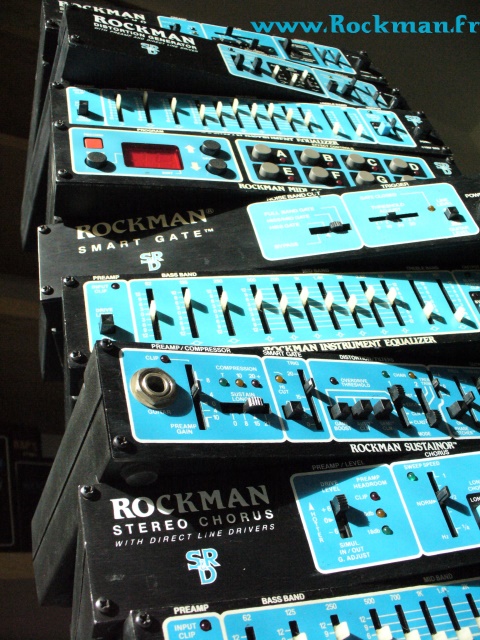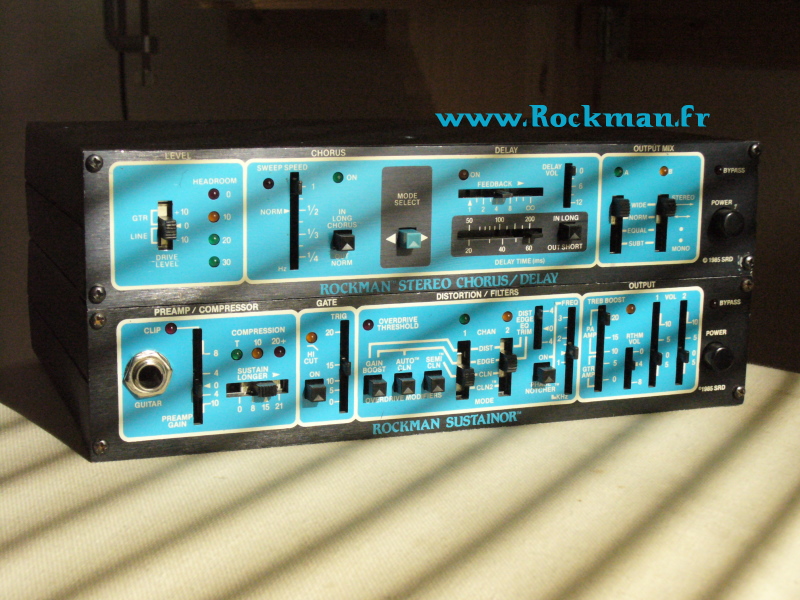 |
The name Rockman was created after Sony's Walkman®, and the name was soon considered as a brand in itself, "SR&D" being just a logo on the gear. The Rockman headphone amp made the name famous, but twenty years later, it is, more than anything, a souvenir from the eighties.
For the collectors, the real stuff is called "Rockmodules".
Tom Scholz's first objective was to design for Boston the gear he couldn't get from the other commercial brands. After the two first albums (Boston, 1976, and Don't look back, 1978), the initial line-up had split, Tom had started recording new material for a third album, and immediately used the Rockman headphone amp. The third album of Boston, Third Stage, was finally released in 1987, and was the first record where all the guitars, to include the bass, were made via direct recording. The Marshall tube's era was over.
Before releasing Third Stage, SR&D had time to design the first series of the Rockmodules. Modules, cause the concept of these half-racks was not really to be used separately. The Rockmodules were designed to be assembled in stage heads, powered by 2x250W linear solid-state amps, driving large full-range three-ways cabs.
You may wonder, and you would be right, what's the use of amplifying a rack which was designed for DI! Ten years of effort to tame the loud tube amps, to get rid of miking the cabs, then... the biggest amps and cabs in Rock'n'Roll Story: 500W per head!
I think that was one of the brilliant ideas of SR&D when they have issued the Rockmodules. The image of the rock guitar player with his huge heads and cabs behind the stage is very strong in the collective culture. Boston plays Arena Rock, and Arena Rock is not something you play sat on a stool, with no visible gear on the stage. Arena Rock, and rock music in general, is also a show. The huge stereo stacks used by Boston were designed mainly for the look. Boston could have played 100% DI with excellent results, all the musicians being connected directly in the main PA system.
Yes, but can you imagine a Boston stage with only a drum set, a Hammond Organ, then... nothing ? Musicians, and also the audience, were not ready for such a revolution.
|
The first time you take a Rockmodule in your hand, the physical sensation is different from every gear you may have touched before. The plastic case is smooth. Not that cold feeling you have with a metal rack. A Rockmodule holds nicely in the palm of your hand: it's compact, the size of an ordinary book. A Rockman Sustainor weighs something like 700g: you feel that the box is not empty! The size is a little surprising, cause we are used to the large 19' racks now.

The two first Rockmodules were the Sustainor and the Chorus/Delay. These two racks provide the same basic sounds as the Rockman headphone amp: CLN & CLN2 clean sounds, Edge and Dist saturated sounds, Stereo Chorus, and "reverbish" slap back echo. The Rockmodules had what the Rockman was missing: controls allowing customising the sound.
The Sustainor is a two channels amp simulator. It can produce quality sounds ranging from ultra-clean to hi-gain saturation, as well as subtle overdriven or crunchy in-between sounds. The Sustainor has also introduced three original creations:
- The Smart Gate, an integrated efficient noise reduction circuit.
- The Phase Notcher, a filter that mimics the sound of a 4x12 cab.
- The Autoclean, an amazing tool that allows controling the saturation from the guitar volume knob without degrading the sound balance.
The Stereo Chorus/Delay is a unique tool, fairly different from what we would expect today : its objective is to complete the basis sound provided by the Sustainor by various stereo spatialisation methods: stereo chorus, short delay, slap-back, or reverb-like echoing. But it's not a modern digital modulator: the Rockmodules are designed to enhance the sound of the guitar, not to change it...
These two blue-face Rockmodules were only the first bricks of Boston's wall of sound. The next year, in 1987, three additional modules were issued:
- The Instrument EQ, an amazing 12 bands graphic equalizer specially designed for guitar players. Still today, this half rack is one the best EQ's ever produced. The 12 bands makes it mandatory to any guitar player who wants to sculpt precisely his own custom sound.
- The Stereo Chorus and the Stereo Echo, that have replaced the original Chorus/Delay. Once again, these two effects are considered as references, even twenty years later.
After a transition version called "100A" - a sort of draft, produced between March and September 1987, the blue-face Sustainor 100 was replaced by the white-face Sustainor 200. At the end of 1987, the look of the Rockmodules was stabilized, the range of sounds was complete, and SR&D was ready for the next step : Midi control!

The Rockmodules are entirely controled by footswitches, not only for the basic bypass function, but also for various options. The Stereo Chorus has, for example, a total of 4 control jacks on the rear panel, while the Sustainor has "only" three! Using standard footswitches becomes rapidly a real nightmare, and the only solution was to design a programmable device that would store in patches the configuration of all these switches and apply them at will.
In the 1987 SR&D catalogue, we can see a strange pedalboard that was called "Octopus":

This device is, in fact, a programmable multi-switcher: pressing one of the footswitches recalls a configuration on a series of jacks that are connected to the Rockmodules. This prototype was never issued, and the commercial product was finally split in two: a pedalboard and a switcher, communicating via the Midi protocol. The Midi Octopus was born, and was the first Midiswitcher designed for guitar gear: it can actually be used with every amp or effect that has analog control switches.


 |
1988: the first Rockmodules line was complete, and the gear designed by Tom Scholz for Boston was now available in the form of commercial professional modules.
On the left is a "standard" Rockman rig:
- The Sustainor provides the complete range of basis sounds.
- A pre-distortion EQ allows precise control over the distribution of harmonics generated by the distortion stage.
- A second EQ allows placing with accuracy the guitar in the band's mix, and completes the first EQ'ing in terms of tone.
- The Stereo Chorus controls the overall stereo image.
- The Stereo Echo creates the atmosphere and completes the stereo structure of the sound.
- The complete rig is remote-controled via the Midi Octopus.
So, was it at least possible to duplicate the sound of Boston ? Of course not. Like the Rockman, a standard rig like this one can help someone who wants a sound ą la Boston. It can be used in many different contexts with excellent results. But the sound of Boston requires so much more, to start with the fingers and ears of the band itself. Post-production has also a huge role in the sound of a record, and the corresponding gear is not available to anynone.
Tom Scholz has kept, as for now, a secret weapon of his own: the Hyperspace Pedal was never released as a commercial product. Tom has probably tried other techniques than the Echoplex modification, and could probably have succeeded building a BBD-based HSP. He just didn't, meaning he didn't want to...
The huge work accomplished with the Rockmodules is certainly unique: create custom gear for a given band and at the same time make it available to the consumer market. Tom has probably decided that the HSP had to remain a personal secret...
|
SR&D's story could have ended here. After all, Boston was now equipped with the gear that the leader had always wanted. As a matter of fact, the following SR&D products were not necessary for Boston, and are actually hardly used by the band.
But SR&D was not only Tom Scholz's personal laboratory: it was also a commercial company, i.e. a social entity with a market and some profitability constraints. The next stage of SR&D was thus the era of market-driven products, first in the same mood as the original Rockmodules line, then with some evolutions.
|
